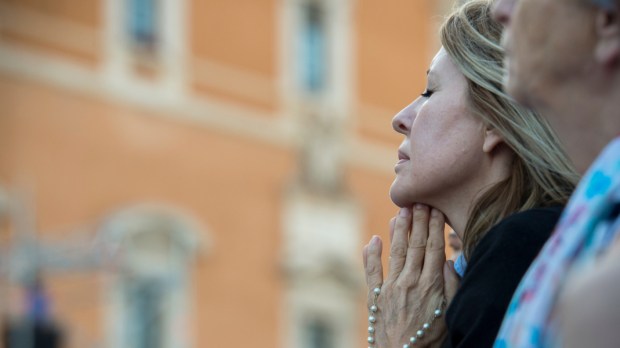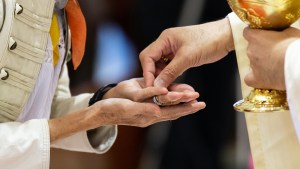Diptychs, that is, two panels joined by a hinge, were a popular form of art in the middle ages. The two images could be closed and protected, making it possible to travel with them. Furthermore, the two panels support each other. Rather than resting alone upright, the joined panels make it possible to easily display the diptych, offering a little resilience and structural security. Finally, according to the plans of the artist or benefactor, the images on each panel were designed to be complementary, speaking to each other.
Today’s Gospel presents a diptych, two examples of professing faith. Joined by the hinge of faith, Jairus and the woman cured of a hemorrhage, embody the two facades of the one united act of faith. These two examples of faith are complementary, each illuminating the other. Like a diptych, the two corresponding figures are a set, a pair.
Jairus, the synagogue official
What do we know about Jairus? What can we surmise from how Mark’s account presents him? Jairus, an official of the synagogue, would have been a man of some standing in his community. Many of the healing accounts in the Gospels are anonymous, like the woman cured of a hemorrhage. Jairus, on the other hand, is known and named. He must have been a recognized figure, or perhaps someone who continued to testify to Jesus, if his name would have been important to the evangelist and the early Christian community.
However, Jairus’ status raises several questions. Was he ridiculed by his peers for approaching Christ? Did his profession of faith cost him his leadership role in the synagogue? Did he pay a price socially, with his new faith in Christ compromising his status in the town? It seems unlikely that such a decision would be without cost.
Jairus approaches the Lord
Notice that the Gospel carefully details how Jairus approaches Jesus. The Gospel states, “One of the synagogue officials, named Jairus, came forward. Seeing him he fell at his feet and pleaded earnestly with him, saying, ‘My daughter is at the point of death. Please, come lay your hands on her that she may get well and live.’ He went off with him, and a large crowd followed him and pressed upon him” (Mark 5:22-24). Jairus approaches Jesus and honors him as a ruler, falling at the Lord’s feet. Then Jairus makes an argument, telling Jesus the situation at hand, and asking the Lord to respond. Finally, Jairus follows Jesus, hoping that the Lord will cure his daughter.
The faith of Jairus
Jairus’ interaction with Christ highlights the intellectual aspect of faith. Faith is believing, and believing something real. To profess the Christian faith means to assent with the mind to stated tenets of belief. Each Sunday when we profess the Creed, we name those core fundaments of the faith.
In his first papal encyclical, Lumen Fidei, Pope Francis writes, “Christ’s word, once heard, by virtue of its inner power at work in the heart of the Christian, becomes a response, a spoken word, a profession of faith. As Saint Paul puts it: ‘one believes with the heart … and confesses with the lips’ (Rom 10:10). Faith is not a private matter, a completely individualistic notion or a personal opinion: it comes from hearing, and it is meant to find expression in words and to be proclaimed.” Jairus has thought through what he wants to ask of Christ. He knows that Jesus heals, and presents a course of action, a plan. Prostrating himself before Jesus, he states the needs of his heart and professes his belief that by the laying on of hands his daughter will be saved.
The woman with a hemorrhage
Unlike Jairus, a respected and known figure, the woman suffering from a flow of blood was an outcast. According to Jewish ritual law, the flow of blood made her unclean. Moreover, anything and anyone she touched was made unclean. Unlike Jairus, who boldly plants himself in front of Christ and names his requests of the Lord, this woman shyly, humbly approaches Christ from behind. At wits end, having long suffered at the hands of doctors unable to cure her, she reaches out to Christ, in hopes that he will be able to do something.
The woman’s faith
While Jairus exemplifies the intellectual aspect of faith, that there are real things to be believed, this woman demonstrates the role of the will in the act of faith. She does not name terms with Christ or pronounce her desires. For her, it is the heart that leads. She stretches out her hand, driven by will, hoping against hope that Christ will cure her suffering. She chooses Christ, trying to touch just the hem of his garment.
To believe, the heart must assent! Pope Francis writes, “Faith transforms the whole person precisely to the extent that he or she becomes open to love. Through this blending of faith and love we come to see the kind of knowledge which faith entails, its power to convince and its ability to illumine our steps. Faith knows because it is tied to love, because love itself brings enlightenment.” Faith is not merely an intellectual enterprise. It is the twin process of the mind and heart. Faith is knowing, but an acceptance of that knowledge by having chosen.
The diptych
For 12 years this woman lived in darkness. Ceremonially unclean, she had not been able to enter the synagogue and offer worship. Unable to prepare food for her family or participate in the liturgical feasts at home, now she has been given her life back by Christ. Jairus had loved and delighted in his daughter for 12 years, his suffering was the risk of losing her. But the woman cured of a hemorrhage had spent her 12 years of pain, apart, alone. The act of will, the confidence in Christ, the movement from unbelief to belief that is a choice, gave her life and light.
Are we Jairus or the woman? Each believer is at once both. Like Jairus we fear loss and the risk of what we have. Like the woman cured of the flow of blood, we need relief from the present pains and sufferings we bear.
Furthermore, like Jairus, each believer assents with the mind. Arguing our way into faith, believing in the intellect that Christ will save. But like the woman, our intellectual assent occurs only because of the movement of the heart, an act of the will, a choice.


